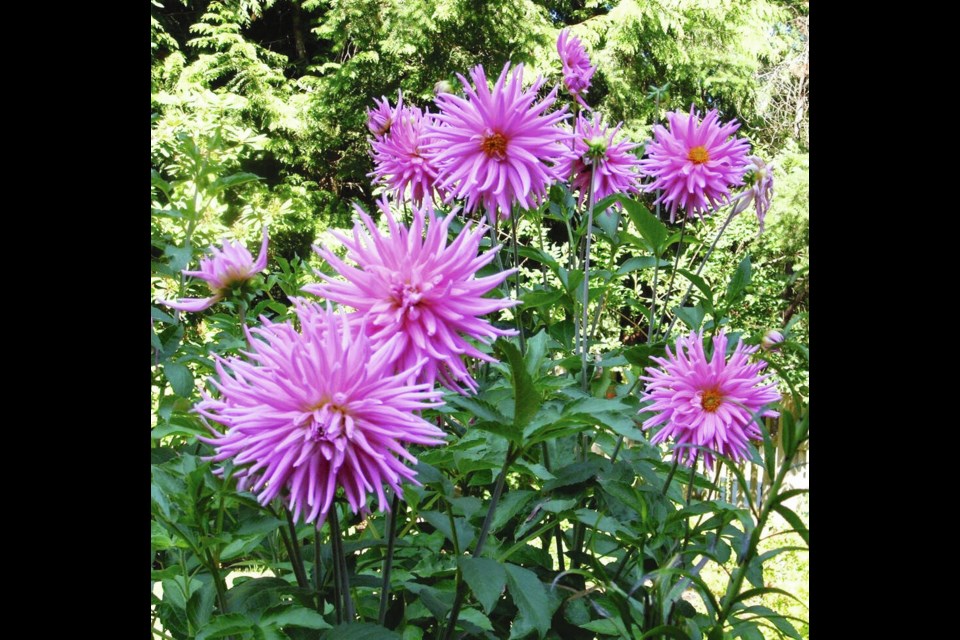Dear Helen: The dahlias that I planted have done very well. My question: Is it advisable to cut them down early in the season to promote shorter, bushier plants rather than tall ones?
H.B.
To encourage side growth and a bushy plant, pinch or cut out the centre growing tip when a plant is between 30 cm and 40 cm tall. Dahlia growers who want the largest possible dahlia blooms for display do the opposite. They let the centre stem develop and remove buds on side growth.
Plants pruned back for bushiness will yield more but smaller flowers.
Dear Helen: Almost two years ago I planted two Portuguese laurels and two English laurels for privacy on my busy corner lot. I’m now thinking about a pruning schedule to keep the plants neatly clipped. I can’t find any definitive information on when to prune.
C.C.
Prune in spring as new growth begins to appear, and follow up with a little trimming in summer to keep the plants tidy. Use secateurs rather than hedging shears on these broad-leaved evergreens, and aim for a shape a little more broad at the plant bases than at their upper parts. This is to reduce shading on the lower areas of the hedge.
Dear Helen: What fertilizer should I use on my apple trees?
M.I.
First, clean up well under and around the trees in the fall. Lime the ground lightly. Early in the spring clean under the trees again and apply lime and fertilizer to the soil before spreading a generous mulch layer over top. Use a high-quality, nourishing compost, purchased or home-made.
For the fertilizer, you have choices. There are two basic kinds — chemically processed ones and natural source products derived from plants or animals.
I’ve not used chemically processed fertilizers for decades. I use lime and a sparing amount of a natural-source fertilizer I mix myself using seed meal, lime, rock phosphate and kelp meal. I mulch with fish compost, because it is easily available where I live and I’ve noticed how well plants respond to it.
Both kinds of fertilizer are sold in most garden centres. Whichever kind you choose, look on the label for an indication the product is suitable for fruit trees. The three numbers on every fertilizer label indicate the levels of the macronutrients nitrogen, phosphorus and potassium in the product. Look for an even balance among the numbers.
When you spread fertilizer under and around a tree, don’t waste any close to the trunk. There’s little or no root action there. Start around 30 cm from the trunk and spread the fertilizer beyond the tree’s “drip line.” That’s the line directly under the outer branch tips. Follow the same placement guideline for compost and other mulching materials. They should not be placed directly against a tree trunk.
Dear Helen: Fresh eggs from a local farm are a favourite food in my family. We are also new, and very keen, gardeners. We would like to know whether there is a use for the shells in the garden. Can they be composted?
E.G.
Egg shells are a good source of calcium and other nutrients that plants need. I have a longstanding habit of putting the shells in a container near my stove top, and letting each layer of shells dry completely before crushing them lightly (not into a powder), making room for more shells.
When the container, usually a large size yoghurt tub, is full of crushed shells, I put it somewhere warm to dry further. Then I place a lid on the container and store it with others full of crushed egg shells.
The crushed, dried shells can be added to a compost heap, in modest amounts at a time, during the growing season. I prefer to use them directly in the garden, to create a sharp-edged barrier to slugs around lettuce transplants. As the season progresses, and the lettuces are harvested, the shells meld into the soil in a sort of on-site composting.
Dear Helen: Later in the fall, as perennials begin dying back, should the fallen foliage be cut off and removed, or left in place?
P.A.
Cut back and remove stems of perennials with soft foliage that dissolves into a sodden mess with cold and wet late autumn weather. This helps promote health and neatness in garden beds.



